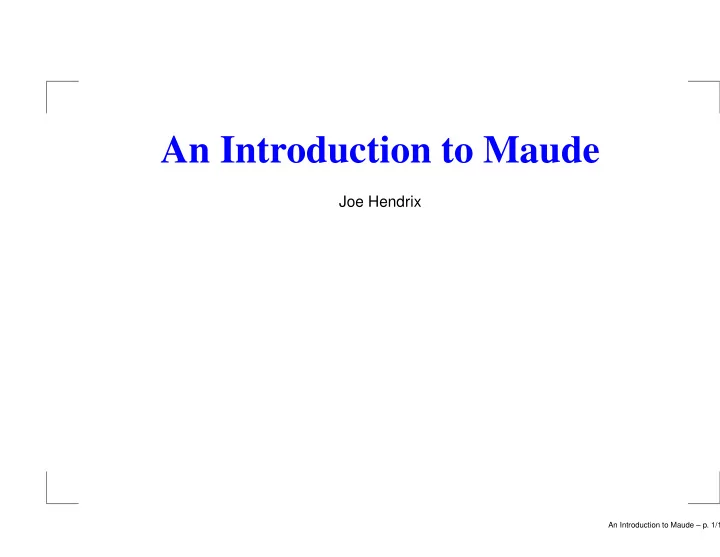

An Introduction to Maude Joe Hendrix An Introduction to Maude – p. 1/12
Talk Outline Maude is many things: Program Language Can be used for representing sequential and concurrent computation. Meta Language Maude can be used to write programs that extend Maude and reason about Maude code. An extended version of Maude called Full Maude is written in Maude itself. Logic The core logic is called Membership Equational Logic and it has an extension for concurrent systems called Rewriting Logic . An Introduction to Maude – p. 2/12
Sorts, Subsorts and Kinds Maude is a typed language where the types are called Sorts . If one type is a refinement of another tyoe, it can be declared as a subsort . e.g. Nat is a subsort of Int. The transitive closure of the subsort declarations forms a connected component called a kind . Type checking is really done at the kind level, determining the sort of a term requires a TM. An Introduction to Maude – p. 3/12
Operators Operators are the building blocks for terms. They are used to define both data and functions. An Introduction to Maude – p. 4/12
Equations Equations define how operations transform. Conceptually equations create equivalent classes and substitute one equal term with another. Rules (explained later) are used to transform terms in ways that do not necessarily subsitute one term for an equivalent one. If the equations are all confluent and terminating, then testing if two terms are equivalent can be done by left-to-right rewriting via the rules into a cannonical form. An Introduction to Maude – p. 5/12
Axioms There are three axioms that can be added as attributes to operator declarations. Associativity Commutativity Identity (left, right, and both) An Introduction to Maude – p. 6/12
Memberships Memberships place terms into sorts. They are used when simple operator declarations are not powerful enough. An Introduction to Maude – p. 7/12
Rules Rules are used to model state transformations - particularly concurrent and non-deterministic computations. Conceptually, rules are not the substitution of equals for equals , but change of state over time. There is an extension to Maude called Real-time Maude that allows one to attach time to each rule transformation. There is another extension called Probablistic Maude that allows rules to be chosen with probabilities instead of non-deterministically. An Introduction to Maude – p. 8/12
Meta Language Maude can be used to reason about Maude code, and hence it is a meta language. For performance reasons, operations at the metalevel can be performed by decent functions that perform computations at the object level. An Introduction to Maude – p. 9/12
Execution Strategy The default execution strategy is to first evaluate the arguments of a term fully, then look for equations that apply to the term itself. Equations are applied in the order they appear in the module. Equations can be tagged with the nonexec strategy so they are not executed by the default strategy. Equations can also have an operator-level evaluation strategy defined so that some arguments are lazy or arguments are evaluated in a specific order. An Introduction to Maude – p. 10/12
Logic Maude has a logic associated with the structure that is used by Maude ITP to prove properties about programs. An Introduction to Maude – p. 11/12
Model Checker Maude has a builtin on-the-fly LTL Model Checker. Can work on any Maude module provided the number of reachable states from the initial state is reasonable. Maude is competitive in performance with SPIN despite having a much-more flexible syntax. An Introduction to Maude – p. 12/12
Recommend
More recommend